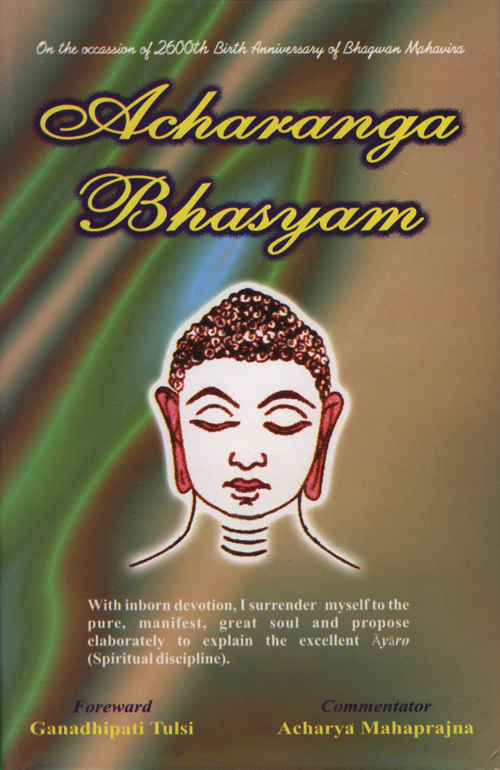1.38 logaṃ ca āṇāe abhisameccā akutobhayaṃ.
Properly understanding the nature of the world (of water-bodied beings) according to the commandment of the Jina, one should make that world completely fear-free.Bhāṣyaṃ Sūtra 38
The water-bodied beings that should be avoided from being injured are not perceptible to human beings. For establishing the existence of the soul in them and for convincing the people who are not capable of direct perception, the Sutra asserts that there are water-bodied beings. The person, possessed of the power of direct perception, can know them directly. If you cannot know them yourself, you should understand them by means of the counsel of persons who are endowed with the power of direct knowledge. After knowing the truth in this way, you should not induce any kind of fear in those beings.
1.39 se bemi - ṇeva sayaṃ logaṃ abbhāikkhejjā, ṇeva attāṇaṃ abbhāikkhejjā. je loyaṃ abbhāikkhai, se attāṇaṃ abbhāikkhai. je attāṇaṃ abbhāikkhai, se loyaṃ abbhāikkhai.
One should neither deny the world (of water-bodied beings), nor should one deny oneself. One who denies the world (of water-bodied beings), denies himself, and one who denies himself denies the world (of water-bodied beings). Thus do I say.
Bhāṣyaṃ Sūtra 39
There are water-bodied beings that are too subtle to be perceptible to the naked eye. The Sutra advices us to know them in comparison to ourselves. One should not deny their existence[1] as one cannot deny the existence of oneself. To the query why one should not deny them, the answer is that their denial would involve the denial of oneself inasmuch as one's soul was subject to birth as water-bodied being infinite times in the past. In other words, the denial of them is evidently the denial of the vicissitudes of oneself.
Asks the disciple: "O Lord, it is very difficult to understand the nature of water-bodied beings, because it is said that they neither hear, nor see, nor smell, nor taste, nor are they found to feel pleasure and pain; there is no throb of life in them, no respiration. Why should they be considered as possessed of souls?" The reply to this query is provided by the Ācārāṅga Niryukti.[2] Just as the body of the elephant embryo at the time of conception, and the watery egg are both sentient liquids, exactly so the water-bodied beings are sentient.[3] This can be syllogized as follows:
Thesis - Water-bodied beings are sentient.
Reason - Because they are liquid, and not injured by any weapon.
Concomitance - Whatever is liquid and not injured by any weapon is necessarily sentient.
Example - (1) Like the embryo (kalala) that is the material cause of the body of the elephant. (2) Like the liquid in the egg that has not developed the organs and where the limbs and the like have not grown.
This problem can also be considered from the standpoint of science. The scientists do not admit the production of water in the absence of oxygen. Does not this necessity of oxygen to produce water prove that there is soul in water?
As in the case of earth-bodied beings in the Sūtra 28 above, one should elaborate the concept of water-bodied beings under the sixteen items beginning with respiration and ending in psychical colouring.[3]
1.40 lajjamāṇā puḍho pāsa.
Look at various self-restrained monks ashamed of their violent activities.
1.41 aṇagārā motti ege pavayamāṇā.
Some people style themselves as homeless mendicants.
1.42 jamiṇaṃ virūvarūvehiṃ satthehiṃ udaya-kamma-samāraṃbheṇaṃ udaya-satthaṃ samāraṃbhamāṇe aṇṇe vaṇegarūve pāṇe vihiṃsati.
But they indulge in violent actions to water-bodied beings with various weapons which involve distruction of various other classes of living beings.
1.43 tattha khalu bhagavayā pariṇṇā paveditā.
On this subject, the Lord has propounded the principle of comprehension and abandonment.
1.44 imassa ceva jῑviyassa, parivaṃdaṇa-māṇaṇa-pūyaṇāe, jāῑ-maraṇa- moyaṇāe, dukkhapaḍighāyaheuṃ.
Longing for survival, praise, reverence and adoration; life and death, emancipation; and elimination of physical and mental suffering.
1.45 se sayameva udaya-satthaṃ samāraṃbhati, aṇṇehiṃ vā udaya-satthaṃ samāraṃbhāveti, aṇṇe vā udaya-satthaṃ samāraṃbhaṃte samaṇujāṇati.
He himself indulges in killing the water-bodied beings or instigates others to do so or approves of such killings by others.
1.46 taṃ se ahiyāe, taṃse abohῑe.
Such violence is for his harm, is for his non-enlightenment.
1.47 se taṃ saṃbujjhamāṇe, āyāṇῑyaṃ samuṭṭhāe.
He (the ascetic) comprehends the result of violence and applies himself to the practice of self-restraint.
1.48 soccā khalu bhagavao aṇagārāṇaṃ vā aṃtie ihamegesiṃ ṇāyaṃ bhavati - esa khalu gaṃthe, esa khalu mohe, esa khalu māre, esa khalu narae.
Hearing from the Jina or other ascetics, some people come to know: such violence is indeed a knot, is delusion, is death, is hell.
1.49 iccatthaṃ gaḍhie loe.
Nevertheless, people entrapped in pursuit of pleasure (indulge in violence to water-bodied beings).
1.50 jamiṇaṃ virūvarūvehiṃ satthehiṃ udaya-kamma-samāraṃbheṇaṃ udaya- satthaṃ samāraṃbhamāṇe aṇṇe vaṇegarūve pāṇe vihiṃsati.
They indulge in violent actions to water-bodied beings with various weapons, which involve destruction of various other classes of living beings.
1.51 se bemi—appege aṃdhamabbhe, appege aṃdhamacche.
Thus I say—somebody pierces or cuts the blind (water-bodied beings that have the feeling of intense pain like that of the human beings born blind, deaf, dumb, lame and deficient in other limbs).
1.52 appege pāyamabhe, appege pāyamacche.
Some people pierce and cut foot, ankle, leg etc. (see Sutra 29 for all the thirty-two limbs of the body).
1.53 appege saṃpamārae, appege uddavae.
Sometimes a person is beaten to a state of unconsciousness and sometimes tortured to death.
Bhāṣyaṃ Sūtra 53
The Sūtras 40 to 53 are to be explained like the Sūtras 17 to 30.
 Acharya Mahaprajna
Acharya Mahaprajna

